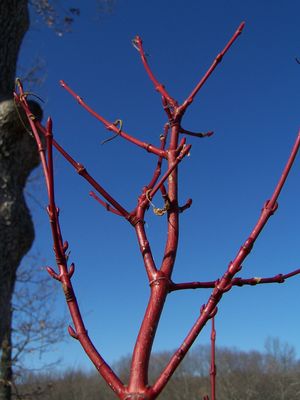View All Plants :: View All TREES
Acer pectinatum subsp. forrestii
Snakebark Maple
Plant Type:
TREESAcer pectinatum subsp. forrestii – This is an extraordinary and not commonly offered small Snakebark Maple tree. Its bark on younger stems is beautiful red in the winter landscape – not a watered-down color but rather a strong, deep rich red reminiscent of some of the better Redtwig Dogwoods complete with fine white stripes, a typical feature of Snakebark Maples. Butter yellow fall foliage color accompanies the increasingly red bark as the weather cools – what a knockout! The very smooth trunk and all older wood settles back to a medium olive color with so many fine white stripes it proffers an ashen olive affect. It is so very handsome and too much ignored. Our plant came from Adam Wheeler at Broken Arrow Nursery where we first saw this beautiful maple. Plant it in front of any colored evergreen backdrop to underscore its amazingly colored bark in winter. Protect from afternoon sun. Though I’ve seen this plant listed as USDA zone 5 hardy ours died to the lower trunk just above the crown in the hard winter of 2009 in northeastern Connecticut. We’ve planted it again! On the east side of our potting shed it is flourishing, glorious and permanent. For gardeners towards the northern end of its range spring planting is advised. Established potted Snakebark Maple, cutting grown.
From Philip C. from Albany, NY on 4.21.2022 wrote: "Acer pectinatum ssp. forrestii from a previous order has been overwintering like a champ! This past winter has been the coldest thus far, experiencing lows around -10F three times, but my plant has had zero die back and is budding out strongly".
More About Acer pectinatum subsp. forrestii
- White Pin-striped Red Bark in Winter
- Butter Yellow Autumn Leaves
- Four Seasons Appeal
- Medium-sized Specimen
Characteristics and Attributes for Acer pectinatum subsp. forrestii
Season of Interest (Foliage)
- Spring / Summer / Autumn
Interesting Bark
- Striped
- Colored
Autumn Interest
- Autumn Leaf Color
Light
- Morning Sun / Afternoon Shade
Attributes
- Alee
- Specimen
- Hedgerow
Growth Rate in the Garden
- Medium
Soil
- Fertile
Origins
- Asia
Propagated By
- Cutting Grown
Genus Overview: Acer
So many maples, so little time! There are an extraordinary number of very good species in Aceraceae, many of smaller stature that fit well in smaller landscapes and gardens of any size. Most have multi-season appeal and, indeed, these are the ones to which we at Quackin’ Grass Nursery gravitate. Most are content in fertile draining soils sited in full sun. Others are happier in the part sun conditions akin to the understory stature as suggested by their size. Through the years we have found that many maples when planted in the far northern end of the USDA hardiness range respond well to protection during at least their first winter - preferably more - in the landscape, i.e. use tall stakes set firmly in the ground with burlap attached completely barricading the tree. All of our maple offerings are cutting grown; these plants are not grafted.


